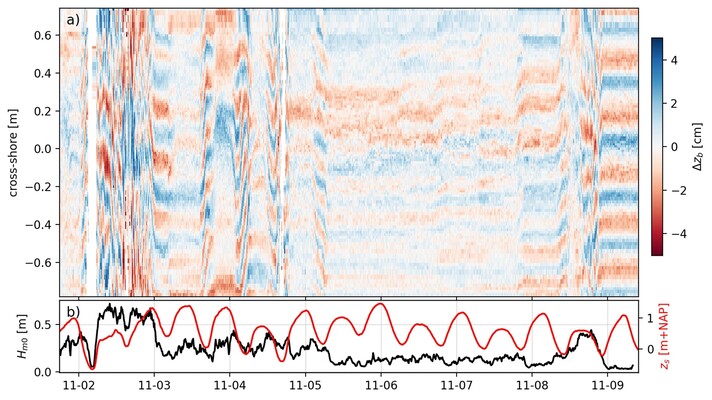M.A. van der Lugt1,2*, M.A. de Schipper1 , A.J.H.M. Reniers1
1 Delft University of Technology, The Netherlands; 2 Deltares, The Netherlands
* Corresponding author: m.a.vanderlugt@tudelft.nl
Introduction
Low-energy, fetch limited sites can have different cross shore profiles than commonly reported on the open coast. Observations of the Prins Hendrik Zanddijk (PHZD), a nourished back-barrier beach on Texel in the Netherlands, showed three persistent sections in the profile: a nearly horizontal Submerged platform, a distinct beach step and a steep beach face around the msl of a steepness varying between 1:8 and 1:10 (van der Lugt et al. 2024). At this low-energy site, sediment mobility is intermittent, and the dominant transport regime is the vortex ripple regime, possibly even during storm. The presence of ripples complicates the mechanisms of cross-shore sediment transport. However, changes in ripple geometry and migration, when closely monitored, can provide estimates of bed load transport under field conditions and thereby aid the understanding of the driving profile-shaping processes at the PHZD.
This research therefore describes the findings on cross shore sediment transport processes at a low energy beach around a storm event, by analysing unique collocated data of hydrodynamics and bedform change as well as topography.
Objective and Methods
We gathered in-situ measurements of ripples and near-bed velocity data from November 1-8 2023 during around storm Ciaràn (November 2nd 2023). A frame was placed just offshore of the beach step, at NAP-1.4 m, containing a Marine Electronics Sand Ripple Profile Scanner and a Nortek Acoustic Doppler Velocimeter. From these observations the bed ripples are classified according to the scheme of Clifton and Dingler (1984), and their predictability through a mobility number is investigated. Migration of the ripples is estimated from 1D and 2D cross-correlation of the reconstructed footprints. The hydrodynamics is used to characterize the changing ripple geometry and drivers for ripple migration. Using the hypothesis that cross-shore ripple migration is a proxy for cross-shore bed load transport under sub-critical flow conditions, the observed intra-wave hydrodynamics are then used in a bed load transport predictor along the lines of Ribberink (1998) and Nielsen (2006). With this predictor we aim to quantitatively capture the drivers of on- and offshore cross-shore bed load transport at this low-energy beach.
Results
Our observations show that both during and in the aftermath of the storm, the bed was rippled with average ripple height of 5 cm and ripple length varying from 10-40 cm, which classify as orbital ripples given the short wave period’s (<5 seconds) at this site. Migration rates were highly varying, both in rate as well as direction. In the week post-storm ripples were observed to both migrate onshore as well as offshore with a rate up to approximately 6 cm/hr. This shows that that moments of migration clearly hold relation with the mobility number as well as moments of enhanced wave nonlinearity. Moments of offshore transport were seen to correlate weakly with undertow, but much less than expected. The comparison of our observations to sediment transport predictors using the intrawave velocity signal quantitatively confirms that cross-shore ripple migration, and therefore bedload, responds strongly to the wave nonlinearity, but does not respond to the mean flow components.

Ripples captured at the PHZD around storm Ciaràn (fall 2023). a) Time stack of the cross-shore swath of the sea-bed (positive y-axis is onshore directed). b) Time series of significant wave height (black) and water level (red).
References
Clifton, H.E. and Dingler, J.R., (1984), ‘Wave-formed structures and paleoenvironmental reconstruction’. Marine Geology 60,165–98.
Nielsen, P., (2006), ‘Sheet Flow Sediment Transport under Waves with Acceleration Skewness and Boundary Layer Streaming’. Coastal Engineering 53, no. 9 , 749–58.
Ribberink, J.S. (1998), ‘Bed-Load Transport for Steady Flows and Unsteady Oscillatory Flows’. Coastal Engineering 34, no. 1–2, 59–82.
Van der Lugt, M.A., Bosma, J.W., De Schipper, M.A., Price, T.D., Van Maarseveen, M.C.G., Van der Gaag, P., Ruessink, B.G., Reniers A.J.H.M. and Aarninkhof, S.G.J., (2024), ‘Measurements of Morphodynamics of a Sheltered Beach along the Dutch Wadden Sea’. Earth System Science Data 16, no. 2, 903–18.


